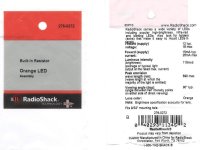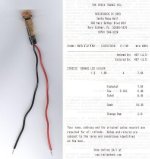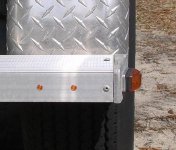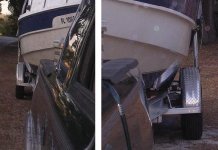Sometimes when trailering my C-Dory 25 a friend following me later says that my trailer lights are not working.  This really concerns me as I want my lights to be working all the time. In the day time there is no way to tell if they are working or not. At night all I can see is the clearance lights.
This really concerns me as I want my lights to be working all the time. In the day time there is no way to tell if they are working or not. At night all I can see is the clearance lights.
I came up with an idea: Install LED lights on the trailer fenders to show the running lights, stop lights, turning signals, and emergency flashers. I bought the yellow/orange LED lights from Radio Shack. They have a 90 degree display angle and are pointed straight forward. They also help as clearance lights. I wired them into the trailer wires at the front of the trailer. I used heat shrink fittings to keep out water and corrosion.
LED Light Package data

LED Light and receipt showing cost of $1.99 per LED light

Installation of LED lights

Looking in the rear view mirrors

When trailering day or night I can visually check my trailer lights anytime by looking back. The outboard LED light is a running light and the inboard LED light is the stop light, turning signal, and emergency flasher. :lol:
I came up with an idea: Install LED lights on the trailer fenders to show the running lights, stop lights, turning signals, and emergency flashers. I bought the yellow/orange LED lights from Radio Shack. They have a 90 degree display angle and are pointed straight forward. They also help as clearance lights. I wired them into the trailer wires at the front of the trailer. I used heat shrink fittings to keep out water and corrosion.
LED Light Package data

LED Light and receipt showing cost of $1.99 per LED light

Installation of LED lights

Looking in the rear view mirrors

When trailering day or night I can visually check my trailer lights anytime by looking back. The outboard LED light is a running light and the inboard LED light is the stop light, turning signal, and emergency flasher. :lol:


